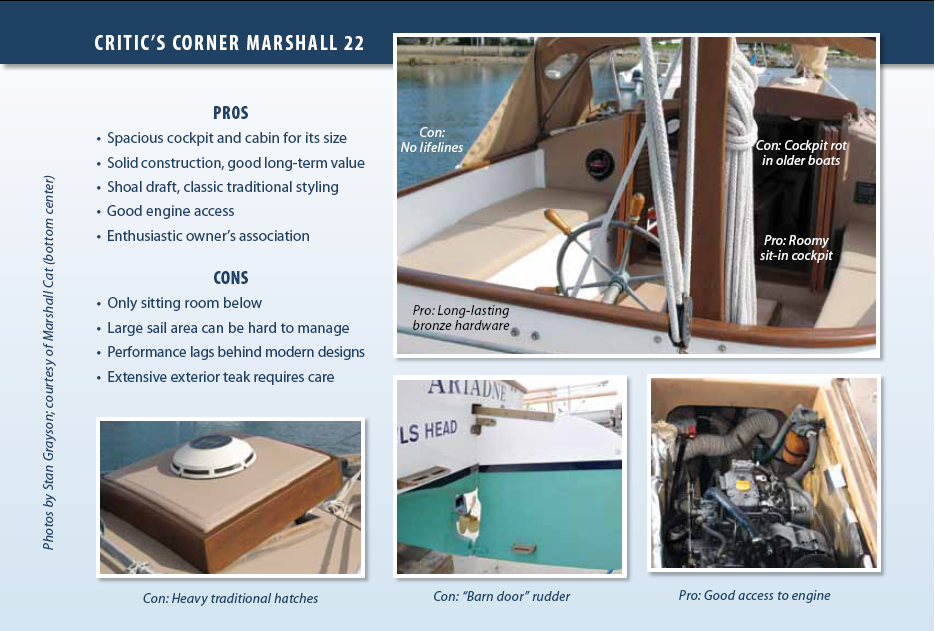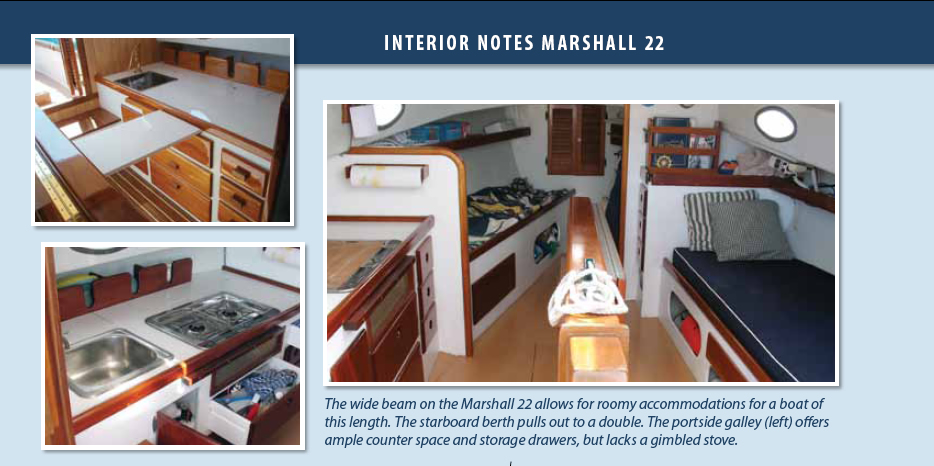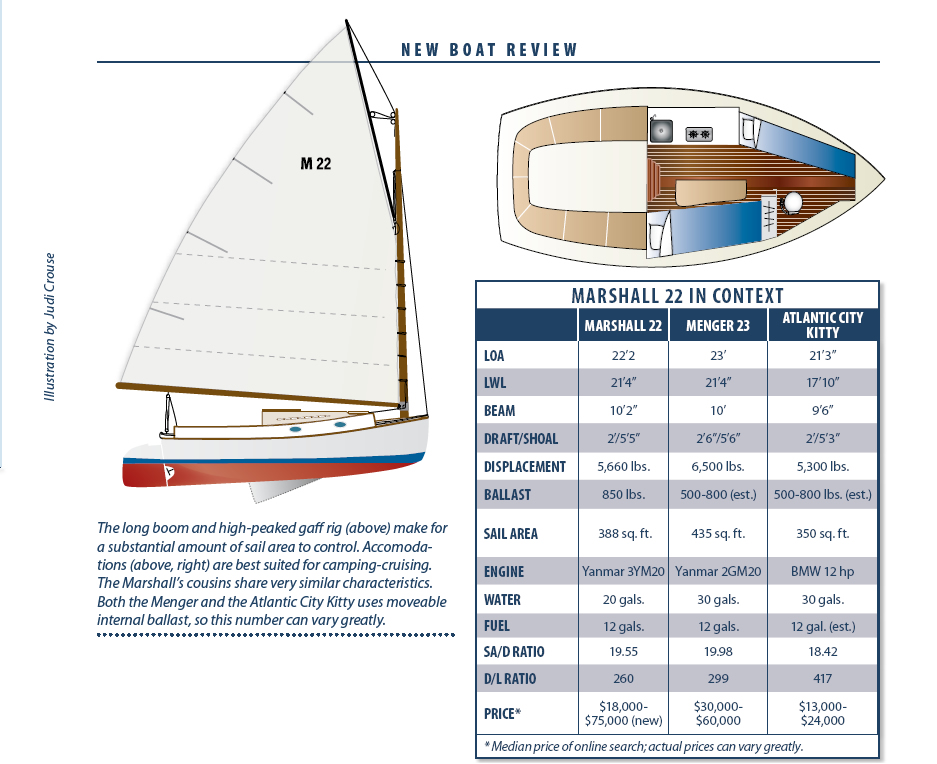Photo by Stan Grayson

Founded in 1962, Marshall Marine is a rarity, a pioneer of fiberglass sailboats that is still in operation, still family owned, and still catering to an enduring niche market. Those who recall the companys earliest days attribute its successful launch to three things. First, the late Breckenridge Breck Marshalls timing was impeccable. His first catboat caught the market when interest in a traditional boat built of fiberglass was just taking off. Second, Marshalls move from his original location in the New Hampshire woods to South Dartmouth, Mass., put him in the right place at the right time. Third, the boats design, construction, and practicality exceeded customer expectations, and word spread.
Todays lineup includes all three catboats originally developed by Breck Marshall: the 18-foot Sanderling unveiled at the 1963 New York Boat Show, the 22 (based on the 18 and introduced in 1965), and the 15-foot Sandpiper of 1972. Positioned as the companys family cruiser, the 5,660-pound displacement 22 is a hefty little vessel. Although used primarily as a daysailer and weekender, some 22s have made ambitious coastal passages, including New England to Florida and back.
Design
Behind Breck Marshalls success lay an impressive sailing resume that ranged from classic catboats to ocean racing. When he returned from naval service in the South Pacific, Marshall acquired a 28-foot catboat that he promptly modified with an 8-foot bowsprit and a 52-foot mast. Zamboanga could spread nearly 1,300 square feet of sail and became a force to be reckoned with on Narragansett Bay, R.I.
An astute observer of boats and the marine trade, Marshall believed that fiberglass represented the future. After a stint with fiberglass innovator Carl Beetle in New Bedford, Mass., Marshall became foreman at American Boat Builders in East Greenwich, R.I. This company tooled up to build Bill Tripps iconic Block Island 40 in the late 1950s. Although his experience was primarily racing and building bigger sailboats, Marshall saw a market for a low-maintenance, Cape Cod catboat. Long a staple of fishermen and yachtsmen, the beamy, centerboard catboat was well adapted to local conditions that combined shoal water, strong breezes, and powerful currents. The first boat derived from an 18-foot, marconi-rigged catboat featured in Yachting in 1944. Marshall acquired the rights and a few station molds for the boat, which had been designed, built, and raced by a skilled Rhode Island sailor named Ernest Pop Arnold.
Together with his shop foreman, Marshall spent three weeks developing Arnolds design for fiberglass production. To create what Marshall initially dubbed the Custom Catboat 18, they increased the sheer, hollowed the bow at the waterline, revised the stem, and replaced the marconi rig with a gaff rig. By the end of 1964, 18 boats, now called the Marshall Sanderling, had been sold. In 1965, Marshall took off the lines, refined and sharpened the bow sections, and brought his drawings to renowned boatbuilder Alan Vaitses. Vaitses did the lofting required to scale the 18-footer up to 22 feet and built the plug used to create the mold.
The Marshall 22 is an evocative rendition of a classic Cape Cod catboat. The 10-foot, 2-inch beam is not quite half of the boats 21-foot, 4-inch waterline, a general catboat rule-of-thumb. The vertical transom carries the familiar barn door rudder. A big centerboard trunk with a hinged table divides the cabin. The 29-foot mast is, of course, right in the bow (making it easy to reliably secure the end of the anchor rode). While the 388-square-foot sail is significantly smaller than that of a 19th-century engineless catboat of comparable size, todays sailors find it more than enough.
The first 22-footer was entered in the 1965 Newport-Block Island race. Years later, Breck Marshall still remembered his amazement at the owners decision to shake out both reefs when the breeze dropped from 30 to 25 knots. Grimalkin placed second on elapsed time, and won on corrected time. Catboats were promptly banned from the event for the stated reason that they were not self-righting, but 46 years later, that first Marshall 22, renamed Grayling, is still sailing.
Accommodations
The earliest boats had an open layout with a pull-out double berth to starboard and galley counter with sink and alcohol stove to port. A hanging locker was positioned ahead of the galley area, and two small berths were located on either side forward with a toilet between them. Beginning around the late 1960s, the head was repositioned to starboard, behind a partial bulkhead and curtain that separate this forward-most part of the cabin, affording some level of privacy. Drawers, shelves, and bins are located throughout.
The interior is reasonably comfortable for two adults. What is lacking, of course, is standing headroom. The topsides are deliberately low, reducing windage but allowing just enough seated headroom for those about 5-foot, 11-inches tall. Ventilation can be an issue. Most 22s have a forward hatch that is not hinged and requires a make-shift support to hold it open. Newer boats have a modern-style hatch. In all cases, a 24-hour hatch-mounted solar-fan is useful to battle mildew. An opening port is located at the front of the cabin on many boats, and many have optional louvered cabin doors. Some owners have installed a dorade vent.
The Marshall 22s cockpit is larger, more unencumbered, and more comfortable than those of many significantly larger boats. The great majority of owners purchase the optional dodger, onto which an available cockpit awning zips. Said one owner: The dodger is a must as it vastly increases living space and crew comfort.
Deck Layout
The sidedecks have molded toerails and are just wide enough so that one can walk forward to the mast. Catboats offer limited deck space for anchor handling, making the optional teak anchoring bowsprit desirable for cruising. Other than when anchoring, mooring, or reefing, there is little need to venture beyond the cockpit. Peak and throat halyards and a topping lift belay on the cabintop. Later boats have useful fairleads to guide the halyards aft. No halyard winches are installed or deemed necessary by most owners.
The extruded aluminum mast is tapered, and the bottom six feet are foam-filled to increase stiffness. The only standing rigging is the traditional forestay. Older masts should be examined for evidence of corrosion caused by the stainless-steel screws attaching the stainless gooseneck. Occasionally, a new mast is the safest approach. A stainless steel, vinyl-lined gaff saddle is used rather than jaws. The saddle is durable, but it and the gaff hardware on which its mounted require prompt replacement if anything has become bent.
Prospective buyers should carefully inspect this sail during a sea trial. A kink at the inboard end of the batten pockets usually means stretched fabric that will benefit little from re-cutting. Longtime owners recommend getting detailed, written quotes from at least two sailmakers experienced with gaff-rig. Buyers should also be sure the boat they are interested in has at least two rows of reef nettles. Imagine my shock, one buyer related, when I found the previous owner had the sail cut down in size.
Abaft the cockpit coaming is the traveler, made of bronze like all the boats deck hardware. The mainsheet is rigged through a double block on the traveler and another on the boom. Some owners replace these doubles with three larger, single blocks (standard on the Sanderling) and report smoother performance. A stainless-steel socket for the boom crutch is mounted on the cockpit coaming. The sockets wooden mounting pad should be checked for cracks.
The bronze steering wheel drives the linkage that operates the rack. Its a rugged setup, but the nut and bolt used in the linkage should be periodically checked to ensure tightness. The rudder has the traditional hole through which a line can be rigged to manually steer in the rare event of gear failure. Most boats have bronze steps on the rudder and transom. These are critical to safe re-boarding in addition to being very convenient ashore.
Engine access is excellent through a big hatch in the cockpit sole. There are still boats equipped with a Palmer, Atomic 4, or Gray Marine gasoline engine, however, Yanmars 3GM20 became standard in 1980. The raw-water-cooled 2GM20 was adopted in 1985. These diesels can be expected to outlive most owners if properly serviced. When the 2GM was discontinued about 2005, the 3YM20 freshwater-cooled model succeeded it. Boats with a replacement diesel should be carefully surveyed to ensure professional installation and unimpeded routing of all fuel lines.
The 12-gallon aluminum fuel tank is located at the forward end of the cockpit beneath starboard seat. Prospective buyers should check the tank for leakage. If replacement is needed, access is reasonably good. Up until about the mid-1970s, Marshall 22s had an external stuffing box, while later models have an internal box. A survey should include the cutless bearing. Replacing the bearing requires removal of the rudder and prop shaft before the bearing itself can be cut apart and a new one installed.
Construction
The hull and deck (and other components) are molded, as they always have been, by Pine Grove Plastics in Freetown, Mass. Hull lay-up is by hand, using mat and roving bonded with polyester resin according to the schedule developed by Marshall himself. Seven basic plies are used with additional layers applied in the forepeak, garboard area and centerboard trunk. Composed of 25 plies, the mast step is laminated in its own mold.
In 2009, closed-cell foam replaced plywood in several key areas. These include the transom and rudder cores, the main cabin bulkhead, and the floor frames. Some older boats suffered water intrusion into the plywood transom or rudder cores, usually caused by damage or improperly bedded fittings installed by a previous owner. If such damage exists, its best to turn to professional guidance for repair or replacement. Given the Marshall 22s overall sturdiness and market value, such core repairs are usually worthwhile.
Cabin and cockpit coamings are solid glass while the cabintop and foredeck are foam-cored except where hardware is installed. Older boats may have developed leaky port lights but removing and rebedding is not difficult. Breck Marshall was especially proud not only of the sturdy hull lay-up, but of the hull/deck joint, which uses no mechanical fasteners. Instead, four successively wider bonding strips of fiberglass are applied, creating a thick fillet and, essentially, a leak-free, monocoque hull/deck unit. No interior liner is used, contributing to easy maintenance, but some boats have dressy cedar staving thats an option for both cabin and cockpit. Teak trim around the cabin coaming and encasing the aft end of the centerboard trunk are options found on many boats.
The plywood-cored centerboard pivots on a bronze pin concealed within the hull laminate. Absent severe damage, the pin should require no attention. The pennant, however, should be checked for chafe.
The most significant structural change occurred in 1983 when a molded fiberglass cockpit replaced the original glassed-plywood sole and plywood seats supported by stanchions. This improved durability, ease of cleaning, and utility. The molded cockpit has three lazarettes in addition to the icebox located portside abaft the bulkhead. The lazarette hinges are well-secured by bronze bolts. The ice box of the earlier glass/plywood is almost certain to need replacement as most develop rot in the plywood, leak air, and offer insufficient insulation.
Some checking can be expected on the interior face of the plywood main cabin bulkhead, but its generally cosmetic. However, the lowest portions of the bulkhead should be inspected for soundness, particularly on boats with the old-style cockpit, with the notoriously leaky ice box. The joint between the seats of the molded cockpit and the cabin is sometimes a potential source of intrusion by rainwater, which will collect beneath the companionway steps. A renewed bead of caulk along the joint will reduce but not eliminate the problem as will the cockpit dodger.
The molded cockpit has two bronze scuppers at the aft end of the centerboard trunk. Each scupper drains through a seacock located beneath the companionway steps. Earlier models simply have drain holes in the aft end of the centerboard trunk.
Those considering purchase of older M22s are likely to find the original gelcoat remains in excellent condition. Hull blisters have seldom, if ever, been a problem. Still, the builder advises that, as a precaution, boats going south where theyll remain in the water for extended periods should have the bottom stripped and barrier-coated.

Performance
With 850 pounds of interior lead ballast, a wide beam, and modest deadrise, the 22 barely budges when one steps aboard. These are stiff sailors, too, and, when properly handled, sail at a modest heel. A drink can left on the sidedeck generally is quite safe. Its a dry boat for its size, but the dodger is an asset once seas build to three feet and winds exceed 15 knots.
The 22 tacks through 50 to 60 degrees depending on wind and sea conditions. Never missed stays in the 13 years Ive had her, said one owner. Competitive sailors emphasize that keeping the mast raked forward is vital to upwind performance as is peaking the sail as high as possible. A 12-knot breeze will produce a speed of about 5.5 knots but a steep chop may well knock off a knot or so. In 15 to 18 knots, the boat can show 6.5 knots plus. One owner who removed his boats engine and filled the skeg aperture reported cruising easily at 6 knots and that hes often seen 7.5 knots speed over the ground.
A key to catboat sailing is learning to reef to reduce excessive weather helm as wind speed increases. A single reef is called for at about a steady 15 knots. The boat is a good single-reef performer and can stand up to 25- to 35-knot gusts when double-reefed. Very light air performance-0 to 5 knots or so-is hampered somewhat by the boats weight and prop drag.
A 13 x 13 prop, three-blade prop is standard. A two-blade prop offers less drag under sail, but a three-blade, noted one owner, will get us through a Buzzards Bay chop twice as fast as a two-blade. Either prop will push the boat to hull speed under most conditions, but the three-blade provides somewhat better maneuvering. Performance in reverse is made trickier by the winds effect on the mast.
Some 40 sloop-rigged versions have been built. The sloop tends to point less well than the cat rig but offers somewhat better balance off the wind. The mast, relocated from forepeak to cabin, does compromise the interior somewhat.
Conclusion
As a weekender or coastal cruiser, the Marshall has much to recommend it, especially to those who can fully exploit its shallow draft, who revel in catboat lore, and who value the boats simplicity and the challenge of its big rig. Construction is unquestionably solid, and the 22 packs a lot of living space into its beamy hull. The original owner of a 38-year-old boat advised: I think looking at a recent boat and comparing it to the one you are considering is a good way to figure out what you miss and where youd need to make some alterations. Having a helpful, customer-focused builder available to promptly supply parts and advice is a bonus.
In 1973, the 22 sold new for about $12,000 and can fetch substantially more than that assuming care and upgrading. Today, new-boat prices range from the base $76,900 to around $90,000 or more. Used boats range from around $18,000 to $70,000 or more. A survey is advisable. Most purchasers can expect to get back about what they paid, assuming proper maintenance and, as sailboats go, the Marshall is a generally reliable investment. Clearly, a 22-foot catboat is not for everyone. It lacks the go-fast adjustments many are accustomed to, and requires development of specific skills. Its beamy hull and big sail are doubtless better adapted to Nantucket Sound than San Francisco Bay. A healthy back and willingness to adopt the catboat crouch when going below are needed.
The Catboat Association, founded in 1962, exists as a clearing house for information, ads, and a source of camaraderie. Its approximately 1,600 members share a fascination with catboat history and technique. Gatherings and races are held from Maine to the Chesapeake and Florida, though Marshalls are now scattered as far as the West Coast. Overall, the Marshall 22 is a capable, good-looking, practical boat that offers a unique combination of quality, safety, fun, and comfort. For our purposes, said one long-time owner, it would be a surprisingly hard boat to replace.









































HELLO Darrell
I am thinking about buying a Catboat, this will help me in my choice.
If you have any other documentation comparing Marshall Sanderling, against other tailorable catboats such as:
Comp-Pac Horizon cat , Arey’s Catboat, or the Menger Cat, I would appreciate it.
Also
Are they all about the same with maintenance?